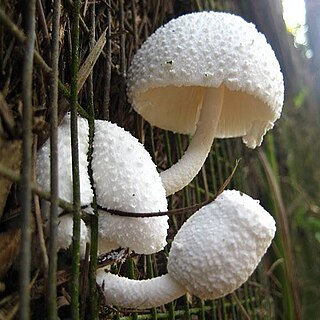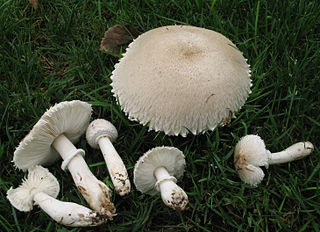
Leafcutter ants, a non-generic name, are any of 47 species of leaf-chewing ants belonging to the two genera Atta and Acromyrmex. These species of tropical, fungus-growing ants are all endemic to South and Central America, Mexico, and parts of the southern United States. Leafcutter ants can carry twenty times their body weight and cut and process fresh vegetation to serve as the nutritional substrate for their fungal cultivates.

Gephyromantis moseri, commonly known as Moser's Madagascar frog, is a species of frog in the family Mantellidae. It is endemic to Madagascar. Its natural habitats are subtropical or tropical moist lowland forests and rivers. It is threatened by habitat loss.

Leucoagaricus leucothites, commonly known as the smooth parasol, woman on motorcycle, ma'am on motorcycle, white dapperling, or white agaricus mushroom, is a species of agaric fungus. The species was originally described as Agaricus leucothites by Carlo Vittadini in 1835, and bears similarity to species of that genus. Solomon Wasser transferred it to Leucoagaricus in 1977. While sometimes regarded as edible, the species is suspected of being poisonous due to gastric-upset-causing toxins. It could also be confused with the deadly Amanita ocreata.

Oenomaus is a genus of butterflies in the family Lycaenidae. The species of this genus are found in the Neotropical realm.

Leucoagaricus is a genus of mushroom-forming fungi in the family Agaricaceae. As of March 2023 there are over 200 accepted species of Leucoagaricus with ongoing research into the genus adding several more each year. Leucocoprinus is a similar genus and considered by some sources to be indistinct from Leucoagaricus based on genetic data that demonstrates they are monophyletic. Species are separated into these genera based on macroscopic features such as cap striations in Leucocoprinus or the more persistent basidiocarps (mushrooms) of Leucoagaricus as well as microscopic features such as the lack of a germ pore in Leucoagaricus species. As a result of the similarities and disagreement on taxonomy, many of the species within these genera have formerly been classified in the other and may still be known by previous classifications. For instance the species Leucoagaricus gongylophorus is cultivated by fungus-growing ants but was formerly known as Leucocoprinus gongylophorus whilst other species cultivated by the lesser attine ants are still classified as undescribed Leucocoprinus species.

Meinhard Michael Moser was an Austrian mycologist. His work principally concerned the taxonomy, chemistry, and toxicity of the gilled mushrooms (Agaricales), especially those of the genus Cortinarius, and the ecology of ectomycorrhizal relationships. His contributions to the Kleine Kryptogamenflora von Mitteleuropa series of mycological guidebooks were well regarded and widely used. In particular, his 1953 Blätter- und Bauchpilze [The Gilled and Gasteroid Fungi ], which became known as simply "Moser", saw several editions in both the original German and in translation. Other important works included a 1960 monograph on the genus Phlegmacium and a 1975 study of members of Cortinarius, Dermocybe, and Stephanopus in South America, co-authored with the mycologist Egon Horak.

Leucocoprinus cretaceus is a species of mushroom producing fungus in the family Agaricaceae. It is likely tropical in origin although it was first documented in Europe where it was often found growing in greenhouses and bark beds. However many early observations conflate this species with Leucocoprinus birnbaumii or Leucocoprinus cepistipes despite sharing only some superficial similarities. This fungus is quite versatile even for a saprotroph and is often found growing in clusters on woodchips, sawdust and compost heaps as well as directly from the ground or on trees. It may also appear in plant pots and greenhouses in colder countries in which it is not well equipped to survive outside.
Phaeocollybia moseri is a species of fungus in the family Cortinariaceae. Found in Chiapas, Mexico, where it grows under pine, it was described as new to science in 1996 by Victor Bandala and Gastón Guzmán. It belongs to the section Versicolores of the genus Phaeocollybia. The specific epithet moseri honors Dutch mycologist Meinhard Moser, "on the occasion of his 70th anniversary and for his contribution to agaric systematics".
Gymnopus moseri is a European species of agaric fungus in the family Omphalotaceae. It was described as new to science in 1997 by mycologists Vladimír Antonín and Machiel Noordeloos from collections made in Sweden. Fruit bodies of the holotype collection were found growing among Polytrichum and in coarse humus and leaves under birch (Betula) and willow (Salix). Collybia moseri is a synonym proposed by Marcel Bon in 1998. The specific epithet moseri honours Austrian mycologist Meinhard Michael Moser.
Conocybe moseri is a mushroom species in the family Bolbitiaceae. It was described as new to science in 1980 by mycologist Roy Watling, from collections made in France. The specific epithet moseri honours Austrian mycologist Meinhard Moser. The fungus has been reported from the United Kingdom, growing in grassy areas, fields, and edges of woods. In 1995, it was recorded from Switzerland, from Ukraine in 2007, and from Russia in 2007. It was reported from India in 2015, where it was found growing on cattle dung.
Tubaria moseri is a species of agaric fungus in the family Tubariaceae. Found in Argentina, it was described as new to science in 1974 by Jörg H. Raithelhuber. The specific epithet moseri honours Austrian mycologist Meinhard Moser.
Psathyrella moseri is a species of agaric fungus in the family Psathyrellaceae. Found in Argentina, it was described as new to science by mycologist Rolf Singer in 1969.
Hebeloma moseri is a species of agaric fungus in the family Hymenogastraceae. Found in Argentina, it was described as new to science by mycologist Rolf Singer in 1969. The specific epithet moseri honors Austrian mycologist Meinhard Moser.
Wardomyces moseri is a species of mold in the family Microascaceae. It was described as new to science by Walter Gams in 1995. The specific epithet honours mycologist Meinhard Moser "on the occasion of his 70th birthday". The type locality was a riverbank in the savanna area east of Villavicencio, Colombia. The fungus was discovered growing on a dead petiole of moriche palm. It differs from other Wardomyces by having conidia that are readily liberated.

Leucoagaricus gongylophorus is a fungus in the family Agaricaceae which is cultivated by certain leafcutter ants. Like other species of fungi cultivated by ants, L. gongylophorus produces gongylidia, nutrient-rich hyphal swellings upon which the ants feed. Production of mushrooms occurs only once ants abandon the nest. L. gongylophorus is farmed by leaf cutter ant species belonging to the genera Atta and Acromyrmex, amongst others.

Leucoagaricus badhamii is a species of fungus in the family Agaricaceae and genus Leucoagaricus. The flesh of this mushroom turns blood red when cut or bruised, hence its common name of blushing dapperling. These damaged areas may eventually turn brown or black and likewise the mushroom may discolour brown or black with age. All parts of the flesh display red staining aiding in identification.

Leucoagaricus barssii, commonly known as the smoky dapperling, or gray parasol, is a species of fungus in the family Agaricaceae.

Leucoagaricus nympharum is a species of fungus in the family Agaricaceae.
Leucocoprinus cygneus is a species of mushroom producing fungus in the family Agaricaceae.










